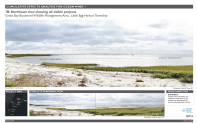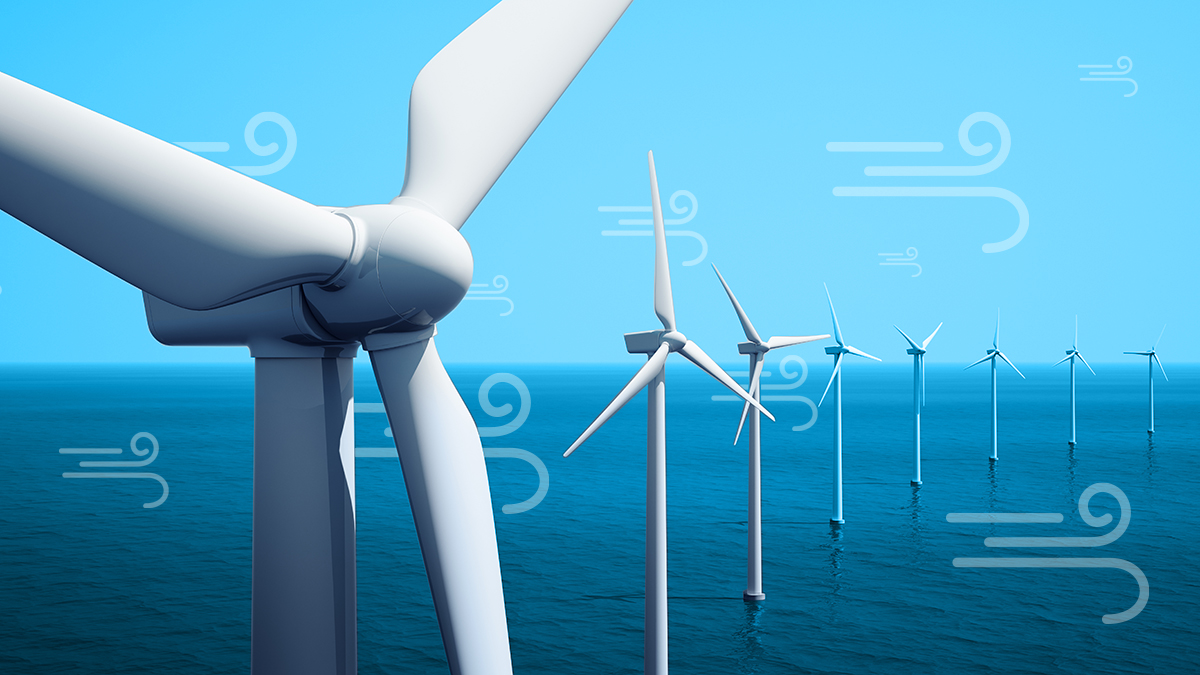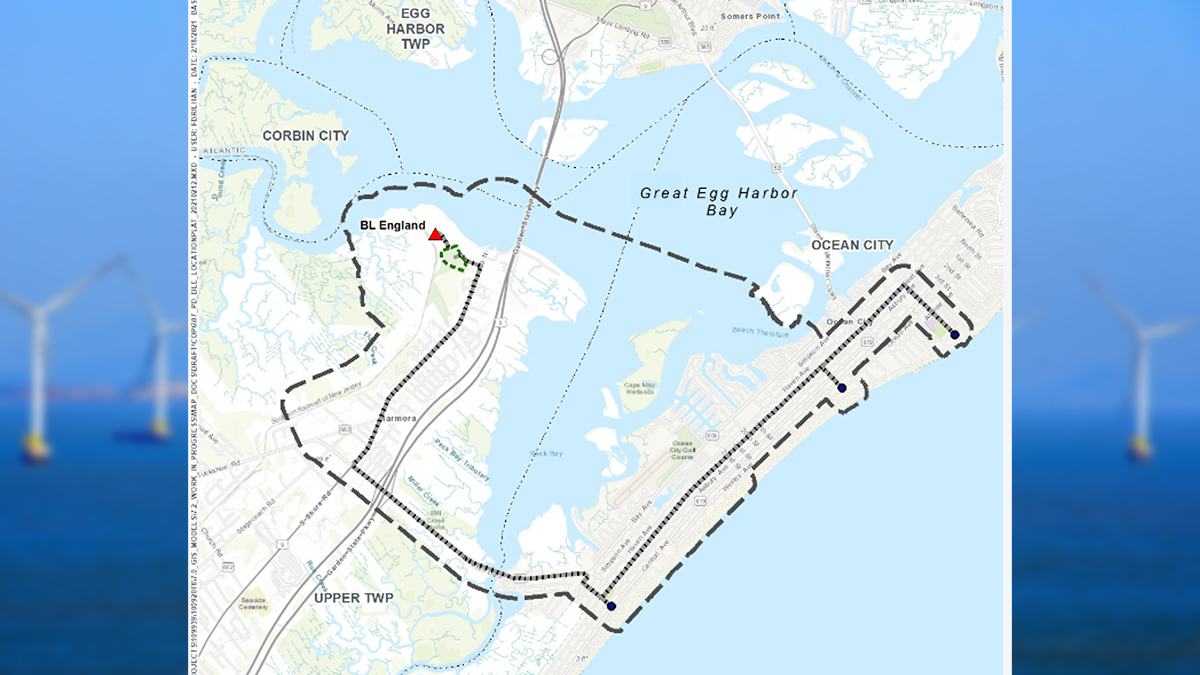They look like small white crosses along the ocean horizon, about an eighth of an inch in size to ocean gazers along New Jersey's beaches and shore communities.
But those little marks are actually giant, spinning wind turbines more than 900 feet tall, and they will span full panoramic views in places like Little Egg Harbor near southern Long Beach Island and Stone Harbor just north of Cape May, according to new illustrations released as part of the state's first planned offshore wind farm.
The images were released for the first time publicly by the U.S. Bureau of Ocean Energy Management on June 17. BOEM published hundreds of pages of analysis, data, graphics and illustrations that reveal much of the details that have not been publicly known about New Jersey's forthcoming offshore wind farms.

Get top local stories in Philly delivered to you every morning. >Sign up for NBC Philadelphia's News Headlines newsletter.
The new federal reports include the Draft Environmental Impact Study for Ørsted's Ocean Wind 1 project, which will be New Jersey's first of several offshore wind farms built in the next decade. The DEIS for Ocean Wind 1 signals the first big step toward federal approval for the project. Ørsted said it expects construction on the 98-turbine project to begin in 2023, with power from the 1,100-megawatt farm beginning generation in early 2024.
That's enough power for about 500,000 New Jersey homes.
“Today, Ocean Wind 1 received its Draft Environmental Impact Statement (DEIS) issued by the Bureau of Ocean Energy Management (BOEM). While we are still reviewing the document, the release of the DEIS marks a critical and exciting permitting milestone for the project in BOEM’s review under the National Environmental Policy Act process and signifies one more step forward to contributing to New Jersey’s renewable energy goals," said Maddy Urbish, Ørsted's head of government affairs and policy in New Jersey. “Ocean Wind 1 recognizes and understands the importance of developing and delivering New Jersey’s first offshore wind farm in a responsible way with a keen eye toward avoiding and minimizing any environmental impacts. We appreciate the efforts across all federal agencies in providing the comprehensive analysis contained within the DEIS and look forward to reviewing it in detail as we begin a robust public engagement process over the coming weeks."
All of the documents combine to show the greatest look yet at how 100s of turbines will alter the ocean views for much of southern New Jersey.
Rising Heights of Offshore Wind Turbines
Wind turbines in the ocean are much bigger than the on-land versions that dominate the landscape in places like the American Midwest. Here is how the largest turbine on the market, General Electric's 12MW Haliede X, compares in size to some well-known structures.

Credit: Nelson Hsu/NBC
The federal release came just a day after another offshore wind developer, Atlantic Shores, held public presentations on the visibility of their 110-turbine farm also planned off New Jersey.
Seeing the turbines, which will reach more than 900 feet above the sea when including the tips of the blades, is one of the biggest concerns for New Jersey residents.
"That is one of our most common questions and there is a lot of interest and concern about what it’s going to look like from the coast," Atlantic Shores Development Director Jennifer Daniels said during the company's presentations on Thursday.

As the federal government begins approving offshore projects like Ocean Wind and Atlantic Shores, the public will have opportunities to weigh in.
After releasing the DEIS on Friday, BOEM said a 45-day window for public comments will begin on June 24, and three public hearings will be held:
- 1 p.m., Thursday, July 14
- 5 p.m., Wednesday, July 20
- 5 p.m. Tuesday, July 26
The 45-day public comment period ends Aug. 8.
Registration for the hearings will be available starting June 24 on BOEM's website.
Offshore Wind Stories
One of the documents released along with Ocean Wind 1's DEIS included the illustrations of hundreds of future turbines, and noted that the nine offshore wind lease areas off the New Jersey coast could eventually contain 1,410 turbines.
The tallest of these could reach more than 1,000 feet into the sky, including the twirling blades.
Those 1,410 turbines make up only a portion of the thousands expected to be erected in the next decade in the Mid-Atlantic off states from South Carolina to Massachusetts.
Gov. Phil Murphy is one of the nation's strongest supporters of offshore wind as "a core strategy" to wean the country off fossil fuels. He has set an aggressive goal of 7,500 megawatts in offshore wind by 2035.
The state has already approved Ørsted's Ocean Wind 1 and Ocean Wind 2 projects, and Atlantic Shores' South project. Those three will generate a combined 3,700 megawatts.
Three more rounds of solicitation and project approvals are expected in the next several years.
The American Clean Power Association touted BOEM's release of Ocean Wind 1's DEIS, highlighting how "offshore wind farms are some of the most carefully scrutinized infrastructure projects in the country, not just in terms of environmental and socio-economic effects, but also in terms of the substantial climate and jobs benefits that their construction and operation bring."
"ACP applauds BOEM for advancing U.S. offshore wind with the publication of its Draft Environmental Impact Statement (EIS) for the Ocean Wind 1 project, the first released under the Biden Administration," the association's vice president for offshore wind, Josh Kaplowitz, said. "Moving forward with a timely review for this project – and others like it in the pipeline – unlocks the enormous untapped potential for U.S. offshore wind to meet our nation’s clean energy and emission reduction goals."



